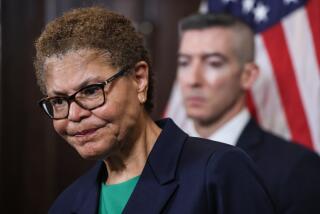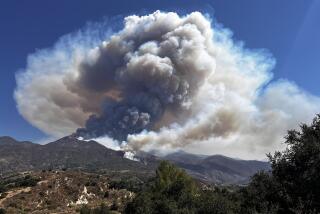Fire Dept. Cuts Number of Safety Inspectors
- Share via
In response to a $6.9-million budget shortfall, the Los Angeles City Fire Department has severely reduced the number of inspectors assigned to monitor safety in public institutions including hospitals, schools, film sets and factories.
In addition, the ranks of battalion chiefs were cut from 16 to 14, which the department estimated will increase the length of time it takes for the supervisors to arrive on the scene of an emergency by five to 10 minutes.
Vacant battalion-chief positions in Glassell Park and San Pedro will remain unfilled, according to Deputy Chief Ralph Ramirez, Fire Department spokesman. Battalion chiefs generally supervise six to eight fire stations and oversee command-post operations at the sites of emergencies and disasters, he said.
“It is almost certainly going to have an impact,” said Fire Marshal and Deputy Chief Jimmy Hill, who oversees the Fire Prevention Bureau, where the inspectors work. “But I think that with the people I have I can still manage and keep a high degree of public safety.”
As of Sunday, 43 out of 175 inspectors were ordered to report for duty as firefighters, while their colleagues prepared to deal with staffs that in some areas had been cut in half.
In the film inspection unit, for example, the number of inspectors was reduced from six to three, a move that firefighters and movie producers say could lead to tragedies like the death of a crew member in San Bernardino County on a Disney set last week. The cutback has left just three inspectors to examine thousands of film and television sets in Los Angeles, and the same three firefighters must also process all permits for use of pyrotechnics, helicopters and tents.
“It’s going to happen sooner or later,” said Inspector Larry Shipp, who found himself running the tiny unit on Monday after his captain was transferred out. “They’re going to have an earthquake or a flash fire and they’re not going to be able to get out of the building. And then we’ll go back and reexamine this thing.”
Other cuts include reducing the unit that inspects schools and churches from six people to three, and cutting the number of industrial inspectors from 31 to 13.
“We don’t particularly like it, but there doesn’t seem to be any other way to resolve how we’re going to take care of this budget issue,” said Battalion Chief Mike Bowers, who supervises the film, school and church inspectors. “My concerns are for public safety.”
The City Council approved the Fire Department’s plan Feb. 17 in an unanimous vote. Councilwoman Laura Chick, who chairs the public safety committee and is generally an advocate for the department, said the vote was taken quickly, “before I even sat in my chair.”
Chick said that the city had little choice but to approve the plan. The alternative, she said, would have been to reduce the ranks of firefighters themselves.
“I think we are taking some risk,” Chick said. “But I don’t think that we had a choice.”
The transfers, according to Hill and others, are meant to be temporary. The department has promised to return the inspectors to their old jobs when the next fiscal year begins in July.
The Fire Department cuts were made as part of the city’s response to a midyear budget audit that showed an overall shortfall of $39.5 million in several departments, including the airport, recreation and parks, and planning. The deficit amounts to about 1% of the city’s $2.6 billion budget. Much of it was made up by extra appropriations by the City Council.
But the Fire Department was asked to make up its shortfall internally, according to a report by City Administrative Officer Keith Comrie.
To accomplish that, administrators moved about 200 employees who do not normally work in fire stations--including the inspectors--back to the field.
According to Valerie Melloff, a city auditor who worked on the budget report, the Fire Department ran a similar deficit--$7.7 million--last year, which was made up by the City Council. The year before there was no deficit, she said.
The shortfalls of the past two years were caused by tighter budgeting overall, along with high petroleum prices, a raise for firefighters that had not been budgeted and fewer retirements than had been expected, Melloff said. The 1997-98 deficit came primarily from two funds used to pay for overtime.
But in the entertainment industry in particular, there is concern that even four months of reduced inspections could result in increased injuries in the event of a fire.
According to the Entertainment Industry Development Corp.’s Los Angeles Film Office, inspectors visited 3,474 set locations last year and found violations of fire codes at 1,748 of them.
Fewer inspections, said Mike Bobenko, senior vice president for operations, could mean that hazards are not spotted or that film crews will become lax in following safety rules.
Shipp, the inspector with the film unit, cited the example of a television set he examined in January 1994. He found the doors all blocked by heavy equipment and, even though it was late, ordered the crew to move everything so people could escape in the event of an emergency.
More to Read
Sign up for Essential California
The most important California stories and recommendations in your inbox every morning.
You may occasionally receive promotional content from the Los Angeles Times.








